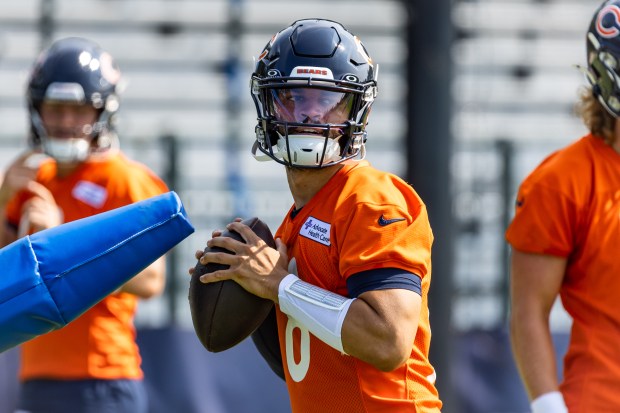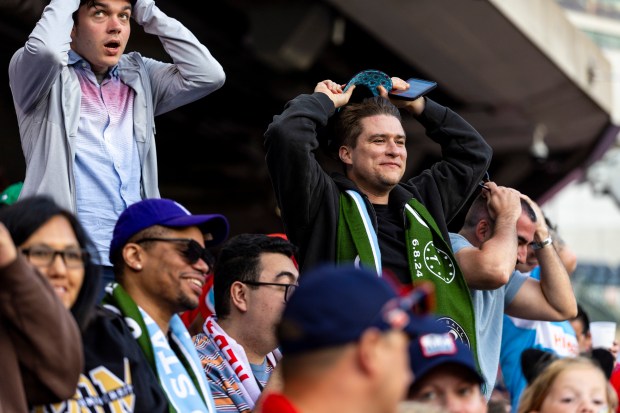On the first snap of 7-on-7 action Sunday morning, Caleb Williams dropped back, took a quick glance at his primary read and the ball was out, delivered to running back D’Andre Swift, a checkdown target, for a short and tidy gain.
It’s not a play that would have induced large applause if the Chicago Bears had a public crowd at their second training camp practice at Halas Hall — this was a closed 85-minute session — but it’s still noteworthy.
What on paper appears to be the best group of wide receiver talent in the history of the franchise — DJ Moore, Keenan Allen and first-round pick Rome Odunze — makes it easy to get carried away wondering what kind of numbers Williams can amass as a rookie quarterback. The receivers have talked about an internal, friendly competition to be the first to 1,000 yards. With tight ends Cole Kmet and Gerald Everett in the mix, there’s an embarrassment of riches compared to what the Bears have had when they’ve played winning football the last several decades and usually been led by their defense.
How productive Williams can be with his big three wideouts will ultimately determine what kind of passing game the Bears have in 2024. But how comfortable Williams is throwing the ball to his running backs will indicate how quickly he is assimilating to the pro game and maturing to live for the next play.
In 20 throws combined during 7-on-7 and 11-on-11 periods, Williams threw a screen pass to Roschon Johnson, who also caught two checkdowns, and added a checkdown throw to Khalil Herbert for a total of five throws to running backs. For what it’s worth, the first passes backup Tyson Bagent threw in his first two series were to running backs.
The sample size is too small to evaluate and proof will be in what transpires when the regular season arrives, but the Bears have a more than capable receiver out of the backfield in Swift and that was billed as a potential strength of Johnson when he was drafted a year ago.
It’s something former Bears assistant coach Pep Hamilton highlighted as an important developmental piece for a young quarterback this spring when asked about steps he put in place when working with Justin Herbert of the Los Angeles Chargers.
“I spent as much time as I could showing him examples of what winning quarterback play looks like in the NFL,” Hamilton said. “The most prominent takeaway during that time when we studied Tom Brady, Drew Brees, was this one simple statistic. Brady and Brees completed close to 35% of their passes on first and second downs to running backs. It was about me getting Herbert to understand the value of taking his checkdowns.”
Chargers running backs combined for 129 receptions when Herbert was a rookie in 2020, a year in which he totaled 4,336 yards and 31 touchdowns, numbers no Bears quarterback has ever reached in a single season. Bears running backs caught 121 passes over the last two seasons combined.
It sounds overly simplistic but in most cases the idea is to take a small positive, a short gain, and simply move to the next down. Second-and-5 creates a lot more possibilities for offensive coordinator Shane Waldron than second-and-10.
Former quarterback Justin Fields was often late to checkdown — the back could be covered by then — and also very comfortable and sometimes electric running late in the play. If Williams can take the throw that is available when it’s available, whether he doesn’t like the window for his primary reads or the defensive look, he can get a small profit and prepare for the next snap. Reality is a more consistent ability to hit checkdown targets — three or four a game — will take pressure off the offensive line on snaps when the quarterback is extending plays and can lead to avoidable hits or even sacks.
“The backs, the tight ends, guys that a lot of time are operating in that underneath zone in the coverage, finding completions to those guys (keeps) the chains moving,” Waldron said. “So if we do get to a third down, we’re in those third-and-manageables instead of third-and-long. Both of those groups, that’s something we know and expect that they can do and will help us throughout the course of the season.”
Waldron’s introduction to the NFL began in 2008 in New England when the Patriots had a handy receiving back in Kevin Faulk. He worked with Sean McVay in Washington when that team had Chris Thompson as a pass-catching threat out of the backfield. It’s not something the Seattle Seahawks did a lot in the last three seasons when Waldron guided that offense, but some of that can be explained by personnel.
The first-year coordinator described a process where the coaching staff will evaluate the strengths and weaknesses of players and then try to lean into what they do best, saying specific game plans each week will vary. Obviously, opponents relying heavily on zone coverage will create more windows for these types of short throws.
While Swift wasn’t used a lot as a receiver last season in Philadelphia, he was targeted 205 times (156 receptions, 1,198 yards) in his first three seasons in Detroit. Fifty of those receptions went for a first down, a pretty good ratio for a checkdown target.
“I feel like I’ll be very valuable in that aspect,” Swift said. “Especially helping Caleb when stuff isn’t open down the field. I’m available.”
If the second day of training camp is evidence, maybe Williams is ready to take what’s given to him when something deeper downfield with the big three isn’t there. It would be a small development but one that, as Hamilton says, leads to winning football.





